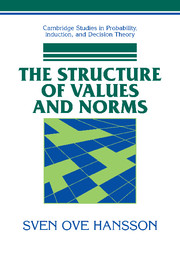Book contents
- Frontmatter
- Contents
- Preface
- PROLEGOMENA
- PART I VALUES
- 2 Exclusionary Preferences
- 3 Preference States
- 4 Changes in Exclusionary Preferences
- 5 Constructing Combinative Preferences
- 6 Pairwise Combinative Preferences
- 7 Decision-Guiding Combinative Preferences
- 8 Monadic Value Predicates
- PART II NORMS
- EPILOGUE
- Proofs
- References
- Index of Symbols
- General Index
5 - Constructing Combinative Preferences
Published online by Cambridge University Press: 13 August 2009
- Frontmatter
- Contents
- Preface
- PROLEGOMENA
- PART I VALUES
- 2 Exclusionary Preferences
- 3 Preference States
- 4 Changes in Exclusionary Preferences
- 5 Constructing Combinative Preferences
- 6 Pairwise Combinative Preferences
- 7 Decision-Guiding Combinative Preferences
- 8 Monadic Value Predicates
- PART II NORMS
- EPILOGUE
- Proofs
- References
- Index of Symbols
- General Index
Summary
In Chapters 2–4, we studied exclusionary preferences, that is, preferences that refer to a set of mutually exclusive alternatives that are taken as primitive units with no internal structure. In actual discourse on preferences, we often make statements that transgress these limitations. In a discussion on musical pieces, someone may express preferences for orchestral music over chamber music and also for Baroque over Romantic music. We may then ask how that person rates Baroque chamber music versus orchestral music from the Romantic period. Assuming that these comparisons are all covered by one and the same preference relation, some of the relata of this preference relation are not mutually exclusive.
The logic of such nonexclusionary or combinative preferences is the subject of this and the following two chapters. In Section 5.1, the relation between exclusionary and combinative preferences is discussed, and it is proposed that the latter be based on the former. In Section 5.2, a formal representation is introduced that covers both (complete) alternatives and (incomplete) relata. In Section 5.3, two major approaches to combinative preferences are identified. The two approaches are then developed in some detail in Chapters 6 and 7.
CONNECTING THE TWO LEVELS
It is almost too obvious to be argued that strong connections should be expected to hold between the preferences that refer to a set of (mutually exclusive) alternatives and the preferences that refer to incomplete relata that are associated with these same alternatives.
Information
- Type
- Chapter
- Information
- The Structure of Values and Norms , pp. 57 - 66Publisher: Cambridge University PressPrint publication year: 2001
